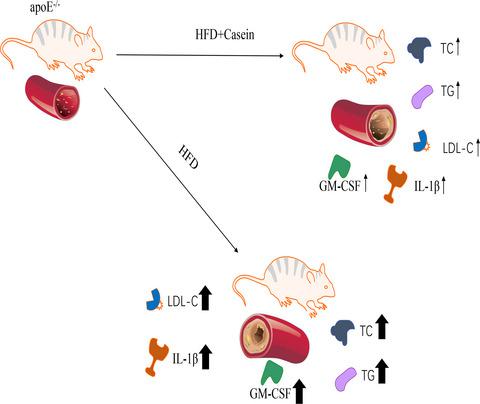当前位置:
X-MOL 学术
›
Food Sci. Nutr.
›
论文详情
Our official English website, www.x-mol.net, welcomes your feedback! (Note: you will need to create a separate account there.)
Subcutaneous administration of casein attenuates atherosclerotic progression in male apoE-/- mice fed with high-fat diet.
Food Science & Nutrition ( IF 3.9 ) Pub Date : 2020-06-07 , DOI: 10.1002/fsn3.1638 Lingbo Hou 1 , Yuting Wang 1 , Mingjing Zhang 1 , Yijun Yu 1 , Ye Gu 1
Food Science & Nutrition ( IF 3.9 ) Pub Date : 2020-06-07 , DOI: 10.1002/fsn3.1638 Lingbo Hou 1 , Yuting Wang 1 , Mingjing Zhang 1 , Yijun Yu 1 , Ye Gu 1
Affiliation

|
The impact of casein on atherosclerotic lesion progression remains controversial. In this study, we tested the effect of casein on atherosclerotic development and its potential mechanisms in male apolipoprotein E knockout (apoE‐/‐) mice fed with high‐fat diet (HFD). Male apoE‐/‐ mice fed with HFD were randomized into HFD group (subcutaneous injection with 0.5 ml of 0.9% sodium chloride daily, n = 6) and HFD + Casein group (subcutaneous injection with 0.5 ml of 10% casein daily, n = 6). Body weight was recorded at baseline and once a week thereafter. After 12 weeks of treatment, plasma lipid and inflammatory markers, and histological characterization of atherosclerotic plaques in the aortic arch and aortic sinus were analyzed. There was no significant difference in weight gain between the two groups after 12 weeks of treatment. Plasma levels of total cholesterol (TC), triglyceride (TG), and low‐density lipoprotein cholesterol (LDL‐C) were significantly lower, while high‐density lipoprotein cholesterol (HDL‐C) level tended to be higher in the HFD + Casein group compared with the HFD group. The positive percentages of atherosclerotic lesions in aortic arch and aortic sinus as well as collagen deposition in aortic sinus plaques were significantly lower in the HFD + Casein group compared with the HFD group. Plasma levels of interleukin (IL)‐1β and granulocyte‐macrophage colony‐stimulating factor (GM‐CSF) were also significantly lower in the HFD + Casein group compared with the HFD group. In conclusion, subcutaneous administration of casein attenuates atherosclerotic lesion progression, possibly through decreasing fibrosis and inflammatory responses in male apoE‐/‐ mice fed with HFD.
中文翻译:

皮下施用酪蛋白可减轻高脂饮食喂养的雄性apoE-/-小鼠的动脉粥样硬化进程。
酪蛋白对动脉粥样硬化病变进展的影响仍存在争议。在这项研究中,我们测试了酪蛋白对高脂饮食(HFD)喂养的雄性载脂蛋白E基因敲除(apoE -/-)小鼠动脉粥样硬化发展的影响及其潜在机制。饲喂HFD的雄性apoE -//小鼠随机分为HFD组(每天皮下注射0.5 ml的0.9%氯化钠,n = 6)和HFD +酪蛋白组(每天皮下注射0.5 ml的10%酪蛋白,n) = 6)。在基线时记录体重,此后每周一次。治疗12周后,分析了主动脉弓和主动脉窦的血浆脂质和炎性标志物以及动脉粥样硬化斑块的组织学特征。治疗12周后,两组之间体重增加没有显着差异。在HFD +酪蛋白中,血浆总胆固醇(TC),甘油三酸酯(TG)和低密度脂蛋白胆固醇(LDL-C)的水平明显降低,而高密度脂蛋白胆固醇(HDL-C)的水平则倾向于更高组与HFD组相比。与HFD组相比,HFD +酪蛋白组的主动脉弓和主动脉窦的动脉粥样硬化病变的阳性百分比以及主动脉窦斑块中的胶原沉积显着降低。与HFD组相比,HFD +酪蛋白组的血浆白细胞介素(IL)-1β和粒细胞巨噬细胞集落刺激因子(GM-CSF)也显着降低。结论,皮下注射酪蛋白可减轻动脉粥样硬化性肝炎喂养的雄性apoE -/-小鼠的纤维化和炎症反应,从而减轻动脉粥样硬化病变的进展。
更新日期:2020-06-07
中文翻译:

皮下施用酪蛋白可减轻高脂饮食喂养的雄性apoE-/-小鼠的动脉粥样硬化进程。
酪蛋白对动脉粥样硬化病变进展的影响仍存在争议。在这项研究中,我们测试了酪蛋白对高脂饮食(HFD)喂养的雄性载脂蛋白E基因敲除(apoE -/-)小鼠动脉粥样硬化发展的影响及其潜在机制。饲喂HFD的雄性apoE -//小鼠随机分为HFD组(每天皮下注射0.5 ml的0.9%氯化钠,n = 6)和HFD +酪蛋白组(每天皮下注射0.5 ml的10%酪蛋白,n) = 6)。在基线时记录体重,此后每周一次。治疗12周后,分析了主动脉弓和主动脉窦的血浆脂质和炎性标志物以及动脉粥样硬化斑块的组织学特征。治疗12周后,两组之间体重增加没有显着差异。在HFD +酪蛋白中,血浆总胆固醇(TC),甘油三酸酯(TG)和低密度脂蛋白胆固醇(LDL-C)的水平明显降低,而高密度脂蛋白胆固醇(HDL-C)的水平则倾向于更高组与HFD组相比。与HFD组相比,HFD +酪蛋白组的主动脉弓和主动脉窦的动脉粥样硬化病变的阳性百分比以及主动脉窦斑块中的胶原沉积显着降低。与HFD组相比,HFD +酪蛋白组的血浆白细胞介素(IL)-1β和粒细胞巨噬细胞集落刺激因子(GM-CSF)也显着降低。结论,皮下注射酪蛋白可减轻动脉粥样硬化性肝炎喂养的雄性apoE -/-小鼠的纤维化和炎症反应,从而减轻动脉粥样硬化病变的进展。



























 京公网安备 11010802027423号
京公网安备 11010802027423号